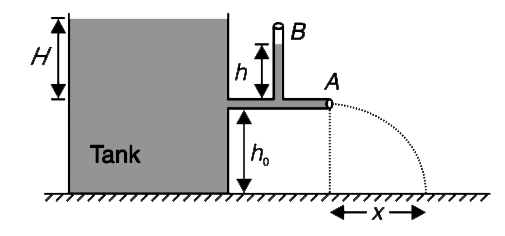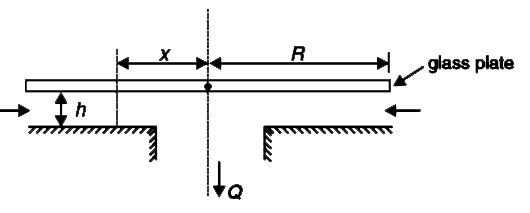A cyslist is traveilling on a circular section of highway of radius 2500 ft at the speed of 60 mile/h. The cyclist suddenly applies the brakes causing the bicycle to slow down at constant rate. Knowing that after 8 second,the speed has been reduced to 45 mile/h. The acceleration of the bicyle immediately after the breakes have been applied. is
2ft/s2
4.14ft/s2
3.10ft/s2
2.75ft2/s
To find the acceleration of the bicycle immediately after the brakes have been applied, we need to calculate both the tangential and radial components of acceleration. Here’s the step-by-step solution:
Step 1: Convert Speeds from Miles per Hour to Feet per Second
We need to convert the speeds given in miles per hour to feet per second for consistency in units.
1 mile = 5280 feet
1 hour = 3600 seconds
- Initial speed (v_initial) = 60 miles/hour
vinitial=60×5280 feet1 mile×1 hour3600 seconds
vinitial=60×52803600≈88 ft/s
- Final speed (v_final) = 45 miles/hour
vfinal=45×5280 feet1 mile×1 hour3600 seconds
vfinal=45×52803600≈66 ft/s
Step 2: Calculate Tangential Acceleration
The tangential acceleration (a_t) can be calculated using the formula:
at=vfinal−vinitialt
Where:
- vfinal=66 ft/s
- vinitial=88 ft/s
- t=8 seconds
Substituting the values:
at=66−888=−228=−2.75 ft/s2
Step 3: Calculate Radial Acceleration
The radial acceleration (a_r) can be calculated using the formula:
ar=v2R
Where:
- v=vinitial=88 ft/s
- R=2500 ft
Substituting the values:
ar=(88)22500=77442500≈3.0976 ft/s2
Step 4: Calculate the Resultant Acceleration
The resultant acceleration (a) can be found using the Pythagorean theorem since the tangential and radial accelerations are perpendicular to each other:
a=√a2t+a2r
Substituting the values:
a=√(−2.75)2+(3.0976)2
a=√7.5625+9.6063
a=√17.1688≈4.14 ft/s2
Final Answer
The acceleration of the bicycle immediately after the brakes have been applied is approximately 4.14 ft/s².
---
We need to convert the speeds given in miles per hour to feet per second for consistency in units.
1 hour = 3600 seconds
vinitial=60×5280 feet1 mile×1 hour3600 seconds
vinitial=60×52803600≈88 ft/s
vfinal=45×5280 feet1 mile×1 hour3600 seconds
vfinal=45×52803600≈66 ft/s
The tangential acceleration (a_t) can be calculated using the formula:
- vfinal=66 ft/s
- vinitial=88 ft/s
- t=8 seconds
The radial acceleration (a_r) can be calculated using the formula:
- v=vinitial=88 ft/s
- R=2500 ft
The resultant acceleration (a) can be found using the Pythagorean theorem since the tangential and radial accelerations are perpendicular to each other:
a=√7.5625+9.6063
a=√17.1688≈4.14 ft/s2
The acceleration of the bicycle immediately after the brakes have been applied is approximately 4.14 ft/s².
Topper's Solved these Questions
Similar Questions
A cyclist is riding with a speed of 18kmk−1. As he approaches a circular turn on the road of radius 25√2m, he applies brakes and reduces his speed at the constant rate of 0.5ms−1 every second. Determine the magnitude and direction of the net acceleration of the cyclist on the circular turn.
View SolutionA cylclist is riding with a speed of 27kmh−1. As he approaches a circular turn on the road of radius 80m, he applies brakes and reduces his speed at the constant rate of 0.5ms−2. What is the magnitude and direction of the net acceleration of the cyclist on the circular turn ?
View Solution
Knowledge Check
- Question 1 - Select One
A cyclist is riding with a speed of 28.8 km/h. As he approaches a circular turn on the road of radius 80 m, he applies brakes and reduces his speed at constant tale of 0.6 ms the magniltude of the net acceleration of the cyclist is
A1ms−2B0.5ms−2C0.75ms−2D1.25ms−2 - Question 2 - Select One
A flock of birds flew into an IndiGo Airbus about to take off at Patna this morning and damaged the plane's engine before the captain slammed the emergency brakes.
The close shave has again forced the glare on the airport already under the scanner for obstacles in its landing approach path. The Airbus A320, carrying 89 passengers and six crew members, had started taxiing when the birds, possibly attracted by the waste pile-up near the airport, crashed into the plane on the left around 8.05 am.
The pilot hit the brakes, bringing the plane to a screeching halt seconds before take-off. Sources said the plane would have been running at a speed of about 40 nautical miles (74 kmph) at the time.
Flight 6E 385 was scheduled to take off at 8.10 am for Delhi and onward to Hyderabad, Bangalore and Visakhapatnam.
"The left-hand side engine of the aircraft got damaged after it was hit by the birds. There were no casualties fortunately and all passengers were taken out of the aircraft immediately after the pilot took it to the parking bay. The aircraft has been grounded and it will operate only after the safety engineers of IndiGo give a fit-to-fly certificate," an IndiGo source at Patna airport said.
All passengers were accommodated on other IndiGo flight:, the source added.
What happened to the plane after the passengers were taken off?AIt was given a fitness certificate.BIt was grounded.CIt was discarded.DIt was inspected and allowed to fly.
A cyclist is riding with a speed of 27 kmh−1 . As he approaches a circular turn on the road of radius 80 m, he applies brakes and reduces his speed at the constant rate 0.5 ms−2. What is the magnitude and direction of the net acceleration of the cyclist on the circular turn ?
View SolutionA cyclist is riding with a speed of 27kmh−1. As he approaches a circular turn on the road of radius 80 m, he applies brakes and reduces his speed at the constant rate 0.5ms−2. What is the magnitude and direction of the net acceleration of the cyclist on the circular turn ?
View SolutionA car is moving with a speed of 4−0km/h−1. As the car reaches a circular turn on the road of radius 100m , the driver applies brakes and reduces his speed at the rate of 1ms2. Calculate the magnitude of net acceleration of the car.
View SolutionTwo stations A and B are 100km apart. A passenger train crosses station A travelling at a speed of 50km/hr. The train maintains constant speed for 1 hour 48 minute and then the driven applies brakes to stop the train at station B in next 6 minute. Another express train starts from station B at the time the passenger train was crossing station A. The driver of the express train runs the train with uniform acceleration to attain a peak speed v0. Immediately after the train attains the peak speed v0, he applies breaks which cause the train to stop at station A at the same time the passenger train stops at B. Brakes in both the trains cause uniform retardation of same magnitude. Find the travel time of two trains and v0.
View SolutionA driver takes 0.20 s to apply the brakes after he sees a need for it. This is called the reaction time of the driver. If he ils driving a car at a speed of 54 km/h and the brakes cause a deceleration of 6.0ms2, find the distance travelled by the car after he sees the need to put the brakes on.
View Solution(i) In the arrangement shown in the figure, the tank has a large cross section and the pipes have much smaller cross section. The opening at A is unplugged and the water jet hits the ground surface at a horizontal distance x.

(a) Find the level of water (h) in the tube B as water flows out of A.
(b) Find x.
(i) A flat horizontal surface has a small hole at its centre . A circular glass plate of radius R is placed symmetrically above the hole with a small gap h remainng between the plate and the surface A liquid enters the gap symmetrically from all sides and after travelling radially through the gap finally exits from the hole. The volume flow rate of the liquid coming out from the hole is Q (in m3s−1).
(a) If the flow speed just inside the circumference of the circular plate is V0 and the speed (Vx) of flow inside the gap at distance x(see figure) from the centre of the hole.
(b) Write Vx in terms of Q, h and x.
 View Solution
View Solution

